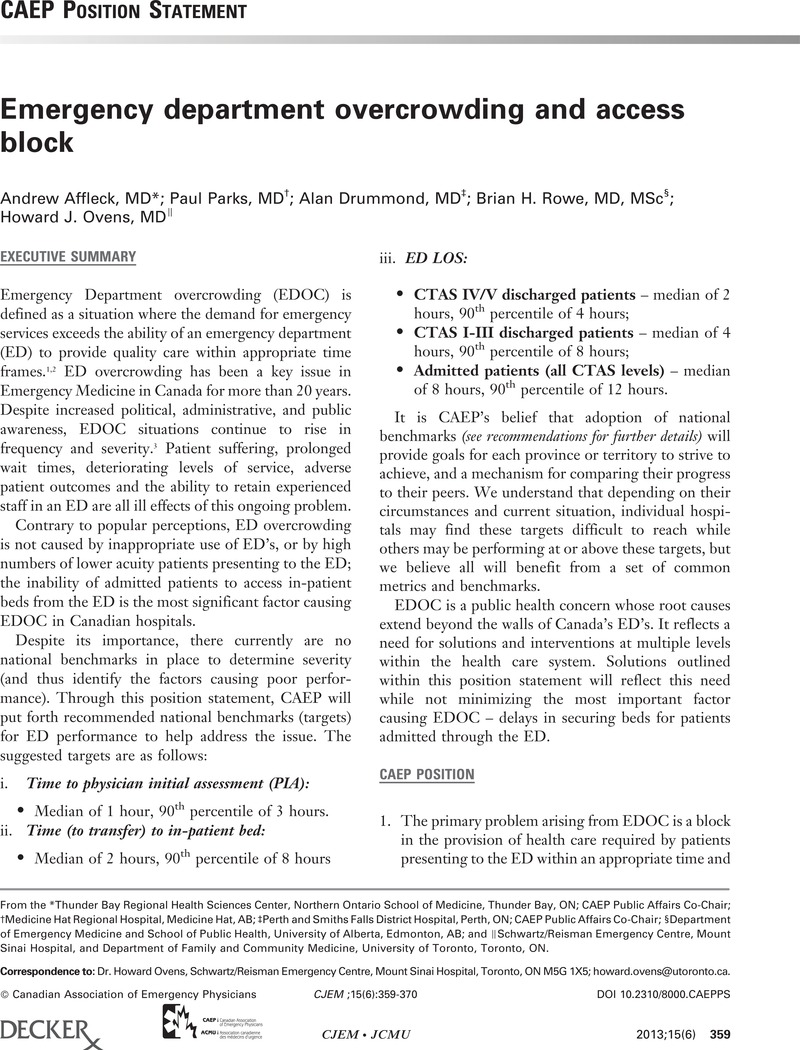Crossref Citations
This article has been cited by the following publications. This list is generated based on data provided by Crossref.
Abualenain, Jameel
Richardson, Drew
Mountain, David
Vaillancourt, Samuel
Schull, Michael
Anderson, Phillip
Revue, Eric
Patel, Brijal
Pourmand, Ali
Shokoohi, Hamid
Hori, Shingo
Quek, Lit‐Sin
and
Mason, Suzanne
2014.
Emergency Care and the Public's Health.
p.
21.
Kawano, Takahisa
Nishiyama, Kei
Hayashi, Hiroyuki
and
Schmidt, Robert Lane
2014.
Adding More Junior Residents May Worsen Emergency Department Crowding.
PLoS ONE,
Vol. 9,
Issue. 11,
p.
e110801.
Kawano, Takahisa
Nishiyama, Kei
Hayashi, Hiroyuki
and
Schmidt, Robert Lane
2014.
Execution of Diagnostic Testing Has a Stronger Effect on Emergency Department Crowding than Other Common Factors: A Cross-Sectional Study.
PLoS ONE,
Vol. 9,
Issue. 10,
p.
e108447.
Boyle, Adrian
and
Mason, Suzanne
2014.
What has the 4-hour access standard achieved?.
British Journal of Hospital Medicine,
Vol. 75,
Issue. 11,
p.
620.
Schull, Michael
Vermeulen, Marian
Guttmann, Astrid
and
Stukel, Therese
2015.
Better performance on length-of-stay benchmarks associated with reduced risk following emergency department discharge: an observational cohort study.
CJEM,
Vol. 17,
Issue. 3,
p.
253.
Ben‐Yakov, Maxim
Kapral, Moira K.
Fang, Jiming
Li, Shudong
Vermeulen, Marian J.
Schull, Michael J.
and
Bonsu, Bema
2015.
The Association Between Emergency Department Crowding and the Disposition of Patients With Transient Ischemic Attack or Minor Stroke.
Academic Emergency Medicine,
Vol. 22,
Issue. 10,
p.
1145.
Schwartz, Brian
2015.
Transfer of care and offload delay: continued resistance or integrative thinking?.
CJEM,
Vol. 17,
Issue. 6,
p.
679.
Boyle, Adrian
2015.
Crowding in emergency departments: guidance from CEM emphasises system-wide solutions.
Emergency Medicine Journal,
Vol. 32,
Issue. 2,
p.
92.
Wang, Teng-Kuan
Yang, Taho
Yang, Chih-Yao
and
Chan, Felix T.S.
2015.
Lean principles and simulation optimization for emergency department layout design.
Industrial Management & Data Systems,
Vol. 115,
Issue. 4,
p.
678.
Copeland, Julie
and
Gray, Andrew
2015.
A Daytime Fast Track Improves Throughput in a Single Physician Coverage Emergency Department.
CJEM,
Vol. 17,
Issue. 6,
p.
648.
Shuaib, W.
Tiwana, M. H.
Chokshi, F. H.
Johnson, J. O.
Bedi, H.
and
Khosa, F.
2015.
Utility of CT head in the acute setting: value of contrast and non-contrast studies.
Irish Journal of Medical Science (1971 -),
Vol. 184,
Issue. 3,
p.
631.
Janke, Alexander T.
Brody, Aaron M.
Overbeek, Daniel L.
Bedford, Justin C.
Welch, Robert D.
and
Levy, Phillip D.
2015.
Access to care issues and the role of EDs in the wake of the Affordable Care Act.
The American Journal of Emergency Medicine,
Vol. 33,
Issue. 2,
p.
181.
Fleet, Richard
Poitras, Julien
Archambault, Patrick
Tounkara, Fatoumata Korika
Chauny, Jean-Marc
Ouimet, Mathieu
Gauthier, Josée
Dupuis, Gilles
Tanguay, Alain
Lévesque, Jean-Frédéric
Simard-Racine, Geneviève
Haggerty, Jeannie
and
Légaré, France
2015.
Portrait of rural emergency departments in Québec and utilization of the provincial emergency department management Guide: cross sectional survey.
BMC Health Services Research,
Vol. 15,
Issue. 1,
Webster, Fiona
Christian, Jennifer
Mansfield, Elizabeth
Bhattacharyya, Onil
Hawker, Gillian
Levinson, Wendy
Naglie, Gary
Pham, Thuy-Nga
Rose, Louise
Schull, Michael
Sinha, Samir
Stergiopoulos, Vicky
Upshur, Ross
and
Wilson, Lynn
2015.
Capturing the experiences of patients across multiple complex interventions: a meta-qualitative approach.
BMJ Open,
Vol. 5,
Issue. 9,
p.
e007664.
Santos, Eduardo
Cardoso, Daniela
Queirós, Paulo
Cunha, Madalena
Rodrigues, Manuel
and
Apóstolo, João
2016.
The effects of emergency department overcrowding on admitted patient outcomes.
JBI Database of Systematic Reviews and Implementation Reports,
Vol. 14,
Issue. 5,
p.
96.
Cheng, Ivy
Castren, Maaret
Kiss, Alex
Zwarenstein, Merrick
Brommels, Mats
and
Mittmann, Nicole
2016.
Cost-effectiveness of a physician-nurse supplementary triage assessment team at an academic tertiary care emergency department.
CJEM,
Vol. 18,
Issue. 3,
p.
191.
McAlister, Finlay A.
Bakal, Jeffrey A.
Rosychuk, Rhonda J.
Rowe, Brian H.
and
Meisel, Zachary F.
2016.
Does Reducing Inpatient Length of Stay Have Upstream Effects on the Emergency Room: Exploring the Impact of the General Internal Medicine Care Transformation Initiative.
Academic Emergency Medicine,
Vol. 23,
Issue. 6,
p.
711.
Cheng, Amy H.Y.
Barclay, Neil G.
and
Abu-Laban, Riyad B.
2016.
Effect of a Multi-Diagnosis Observation Unit on Emergency Department Length of Stay and Inpatient Admission Rate at Two Canadian Hospitals.
The Journal of Emergency Medicine,
Vol. 51,
Issue. 6,
p.
739.
Legramante, Jacopo M.
Morciano, Laura
Lucaroni, Francesca
Gilardi, Francesco
Caredda, Emanuele
Pesaresi, Alessia
Coscia, Massimo
Orlando, Stefano
Brandi, Antonella
Giovagnoli, Germano
Di Lecce, Vito N.
Visconti, Giuseppe
Palombi, Leonardo
and
Bugiardini, Raffaele
2016.
Frequent Use of Emergency Departments by the Elderly Population When Continuing Care Is Not Well Established.
PLOS ONE,
Vol. 11,
Issue. 12,
p.
e0165939.
Wise-Harris, Deborah
Pauly, Daniel
Kahan, Deborah
Tan de Bibiana, Jason
Hwang, Stephen W.
and
Stergiopoulos, Vicky
2017.
“Hospital was the Only Option”: Experiences of Frequent Emergency Department Users in Mental Health.
Administration and Policy in Mental Health and Mental Health Services Research,
Vol. 44,
Issue. 3,
p.
405.





